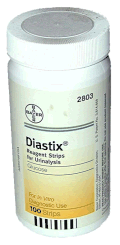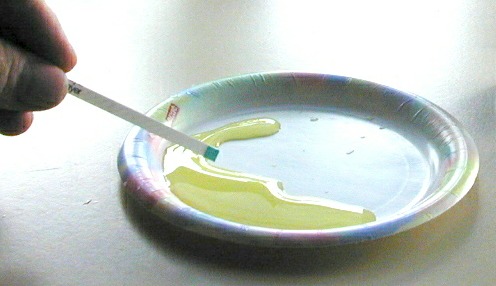
A basenji will not normally have glucose (simple sugar) in his urine. If glucose is present it is likely the basenji has Fanconi syndrome. It is also possible the dog is diabetic, but this is less likely. In any event, detection of glucose should prompt a visit to your vet. The reason we test for glucose in the urine is to catch Fanconi disease as early as possible when it is easiest to manage. The basenji community of breeders and enthusiasts cannot yet predict which dogs are at risk. This is why it is recommended that basenji owners test their dogs monthly for glucose between ages 3-11.

 These
are glucose test strips. You can get them from most pharmacies. Ask for
Bayer "Diastix" or equivalent. There are several other brands and they
all have the same form and function. Other descriptive terms are
"diabetic test strips", "glucose test strips". Some are multi-function
such as "Keto-Diastix" (measures glucose and ketones). These will work
as all you are concerned about is the ability to measure glucose. Be
careful not to get Ketostix or strips that measure only
ketones.
These
are glucose test strips. You can get them from most pharmacies. Ask for
Bayer "Diastix" or equivalent. There are several other brands and they
all have the same form and function. Other descriptive terms are
"diabetic test strips", "glucose test strips". Some are multi-function
such as "Keto-Diastix" (measures glucose and ketones). These will work
as all you are concerned about is the ability to measure glucose. Be
careful not to get Ketostix or strips that measure only
ketones.
Open the bottle and examine a test strip to familiarize yourself with it. Notice there is a "business end" which has a turquoise pad. This is the end that contacts the urine and detects glucose. It has a chemical which changes color in the presence of glucose. You hold the strip on the other end with your fingers.
 Read the instructions on the bottle carefully and
note the glucose
color chart on the bottle. For Diastix it looks like this.
Read the instructions on the bottle carefully and
note the glucose
color chart on the bottle. For Diastix it looks like this. 
Next dip the stick as shown into the urine and tap off any excess. Note the exact second you did this and wait the specified time. At exactly the specified time, compare the color with the chart and see if it changed from the negative color. If the color stays the same, that is it, you are done with the procedure.
Be aware that with most basenjis the color will never change -you are merely taking a reasonable precaution by doing this test. Consider it a normal part of your dog's health maintenance.
Frequency of test should be once a month. In addition, many owners like to test twice over a couple of days to guard against a false negative reading. With experience, some people have been able to dispense with the saucer and dip the test strip right in the stream. This is obviously easier to do with a male.

At some point, you may wish to make sure your test strips are functional. This can be done by dissolving 1 drop plain honey in 1 tbs. water or 1 drop Karo syrup in 1 tsp.water, and then test the solution. Both of these products have ingredients identical to glucose and will change the strip color. Do not use table sugar which is of a different molecule and will not change the strip.